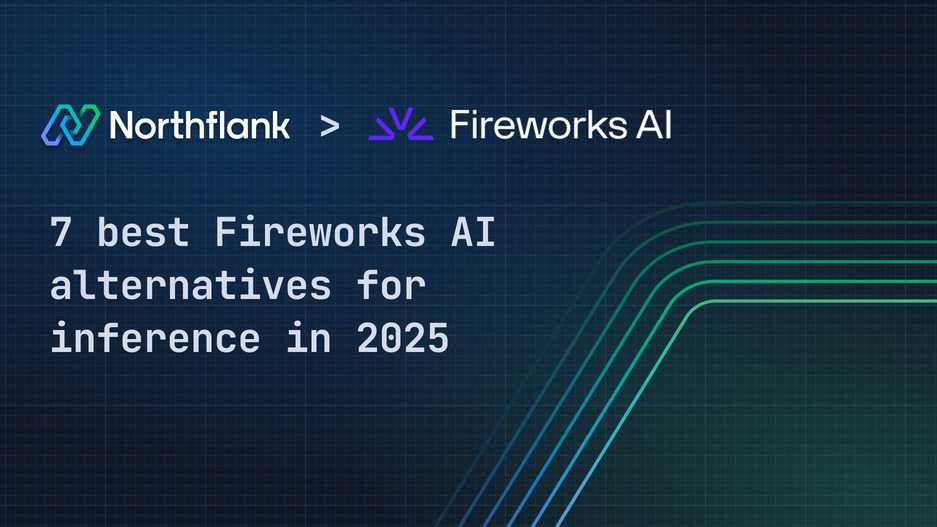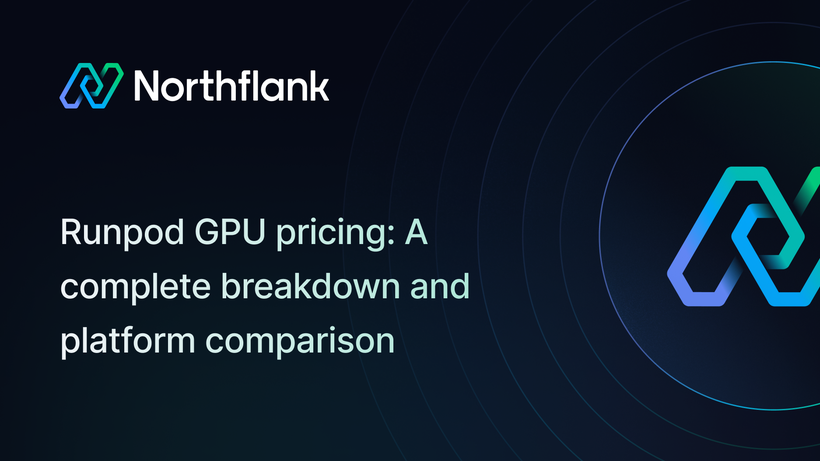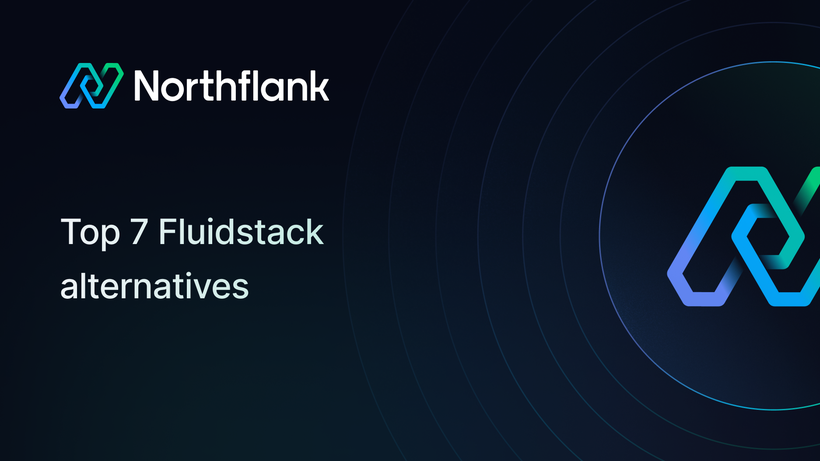

7 best Fireworks AI alternatives for inference in 2025
If you’re searching for alternatives to Fireworks AI, chances are you’re not just chasing lower latency; you’re running into walls. Fireworks gets you from zero to hosted LLM in minutes, but when your use case becomes more complex than calling an endpoint, you need infrastructure that doesn’t vanish behind an API. You need tools that are opinionated enough to help, but flexible enough to stay out of your way.
This guide breaks down the top Fireworks AI alternatives based on how these platforms behave in the hands of engineers shipping real products. We'll look at control, extensibility, stack integration, and the tradeoffs that come with each choice.
Fireworks AI does one thing well: serve optimized open models fast. But once you need to fine-tune, deploy in your own cloud, or run anything adjacent to the model, it becomes clear what Fireworks isn’t trying to solve.
Reasons teams look elsewhere for Fireworks AI alternatives:
- You need infra control – Bring Your Own Cloud (BYOC) isn’t supported unless you’re a major enterprise customer.
Read more: Why smart enterprises are insisting on BYOC for AI tools
- You need to orchestrate more than inference – No support for APIs, queues, jobs, or database-backed workflows.
- You care about compliance or cost transparency – Fireworks’ fully-managed setup hides both optimization opportunities and data residency levers.
- You want better debugging and monitoring – Logs and metrics are thin. There’s no way to trace performance regressions or cost anomalies meaningfully.
What you need next is a platform that treats inference as a component, not the product.
- Inference throughput: Can it handle batch and real-time use cases without falling over?
- Model flexibility: Can you bring your own weights, customize pipelines, or use niche architectures?
- Infra surface area: Are you allowed to deploy in your cloud, or is it a black box?
- System-level integration: Can you run APIs, cron jobs, vector stores, and other components in the same stack?
- Observability: Logs, metrics, tracing, tools for real debugging, not just dashboards.
- CI/CD maturity: Git-driven deploys, rollbacks, staging environments, templated infra, all signal long-term viability.
- Northflank — Infrastructure for real software, not just inference.
- Amazon SageMaker — Enterprise-grade and deeply integrated with AWS, but clunky and complex.
- Google Vertex AI — Excellent for Google-native NLP, less great for OSS models or custom infra.
- Together AI — Great performance, but hosted-only and tightly scoped.
- BaseTen — Good if you want managed inference + observability, and don’t need stack control.
- Modal — Serverless flexibility, but you’ll build everything yourself.
- Replicate — For prototypes and solo builders—not for prod.

Northflank isn’t a model API. It’s a platform for deploying GPU-backed workloads and full systems into your own cloud or theirs. You get control over the compute layer and the app layer (models, APIs, queues, databases, cron jobs), all deployable in a single stack.
- True BYOC support for AWS, GCP, Azure, or on-prem Kubernetes
- GPU-native scheduling with spot/preemptible node support
- Co-locate model inference with APIs, job queues, and stateful services (Postgres, Redis)
- Git-based CI/CD with rollback, health checks, autoscaling, and environment promotion
- Declarative JSON templates for reproducible multi-service architectures
- No built-in model catalog (but they’re working on it, and templates come close). You must containerize or use templates
- Requires some infrastructure familiarity if using BYOC in production
Northflank wraps Kubernetes with a high-level developer experience. Under the hood, each workload runs in its own namespace, with support for GPU resource requests, autoscaling policies, per-environment secrets/configs, and managed service-to-service networking. GPU services can use node selectors or taints to run on dedicated pools. You can define GPU-backed containers that autoscale with load or stay warm across replicas.

SageMaker is the inference backbone for many large enterprises. It gives you detailed control over compute, autoscaling, and security, and plugs seamlessly into the broader AWS ecosystem.
SageMaker lets you deploy models using containers, Python SDKs, or prebuilt endpoints via JumpStart. It supports asynchronous inference, streaming, and multi-model endpoints on a single instance. You can use model registries, versioning, and pipelines to handle full MLOps workflows. Inference is tightly coupled with IAM, VPC config, and other AWS primitives, giving strong governance but requiring deep AWS knowledge.
- Supports multi-model endpoints, GPU/CPU variants, spot pricing
- Deep IAM integration, encryption, and network control
- Good tooling for A/B testing, shadow deploys, and autoscaling
- Steep learning curve; the UX feels fragmented
- Overhead is high for small teams or MVP use cases
- Pricing gets complex quickly if not carefully managed

Vertex AI offers fully managed inference and training with tight integration into GCP. Ideal if you’re using PaLM 2, Gemini, or embedding NLP into an app built on Google's stack.
Vertex AI provides managed endpoints for models trained on AutoML or via custom training pipelines. It supports Tensor Processing Units (TPUs) for inference and connects directly to services like BigQuery, Cloud Storage, and Firebase. You can fine-tune foundation models like PaLM 2 or deploy your own TensorFlow, PyTorch, or XGBoost models. However, deployment of general OSS models like LLaMA requires extra configuration and isn’t as streamlined.
- TPU-backed inference for Google’s foundation models
- Unified interface for training, tuning, and deploying
- Strong support for semantic search and document AI
- Limited flexibility for OSS model hosting
- Requires deep GCP adoption to get full value
- Not BYOC; usage stays within Google’s control plane
🔎 Note: SageMaker and Vertex AI are full-stack ML platforms, designed to cover everything from data prep to training, tuning, and deployment. That makes them powerful, but also heavyweight. If your goal is just to serve models as part of a broader application system, not build an entire MLOps pipeline, they can feel overbuilt. You get a lot of knobs, but not always the ones you actually need for real-time, product-facing inference.

Together AI is a fast, reliable option for hosted model inference across a large library of open-source models. It shines when you want plug-and-play APIs and are okay with living in their cloud.
Together’s platform abstracts the infrastructure entirely. You can rent dedicated GPU endpoints (with token-based pricing) or use serverless endpoints for bursty workloads. They also support LoRA fine-tuning and quantized models out of the box. Their infra is optimized for inference throughput, but there’s no way to colocate your own business logic or services.
- Access to a massive model catalog, including LLaMA 3, Mistral, Mixtral, Falcon
- Supports long-context (128K) inference, LoRA-based fine-tuning
- OpenAI-style APIs, high throughput on dedicated endpoints
- No BYOC; all workloads must run on Together’s infrastructure
- No support for deploying additional services or systems alongside the model
- Pricing can spike for high-throughput or long-context use cases

Baseten focuses on the experience of running inference in production: monitoring, model packaging, and deployment workflows. If you’re an ML team with limited infra capacity, this feels polished.
Each deployment in Baseten is a containerized Truss bundle: Python model + hooks + dependencies. Baseten provisions the infra, adds monitoring (request timing, error rates, throughput), and surfaces usage metrics. But you can’t run custom services or databases. It’s inference-focused.
- Ships with Truss: a model packaging tool with pre/post-processing hooks
- Built-in dashboards, A/B testing, and rollback support
- Integrates with common cloud storage and CI tools
- No BYOC or self-hosted deployment options
- Limited extensibility, can’t deploy full-stack systems
- Customization tied to Truss; harder to swap in custom pipelines

Modal is a flexible compute platform for Python code. You can use it to serve models, batch process documents, or run training jobs, with minimal infra boilerplate.
Modal treats functions like cloud-native microservices. You define @modal.functions with container environments, resource limits (GPU/CPU), and caching directives. Modal handles provisioning, scaling, and invocation via API. But you build everything yourself—no built-in routing, observability, or stack scaffolding.
- Code-first development with native Python decorators
- Scale-to-zero compute with GPU and CPU instance types
- Mount remote storage and load models dynamically
- No BYOC or on-prem execution support
- No prebuilt stack scaffolding, you build everything
- Observability and routing require external setup or tooling

Replicate is the fastest way to deploy and test community models. Great for demos, hackathons, or testing niche models.
Replicate uses Dockerized environments (via Cog) to package models with entrypoint scripts. Jobs run on shared infra with optional GPU use. It’s minimal but effective. Not intended for high-scale production, but great for fast iteration.
- Vast model library with community-maintained endpoints
- One-command deploys using Cog (their CLI + runtime)
- Built-in API keys and per-second billing
- Not designed for sustained production traffic
- Limited visibility into system-level performance
- You’re limited to what Cog + the UI offers, no orchestration
| Provider | BYOC | Full stack support | Model catalog | GPU support | Pricing model |
|---|---|---|---|---|---|
| Northflank | ✅ Yes | ✅ Yes | ❌ No | ✅ Yes | Free tier, usage-based, or custom enterprise (BYOC or managed) |
| SageMaker | 🟡 Partial (AWS only) | 🟡 Partial | ✅ Yes | ✅ Yes | Usage-based + infra costs |
| Vertex AI | ❌ No | 🟡 Partial | ✅ Yes | ✅ (TPU too) | GCP-native pricing (TPU optional) |
| Together AI | ❌ No | ❌ No | ✅ Yes | ✅ Yes | Token-based or dedicated endpoint pricing |
| BaseTen | ❌ No | ❌ No | ✅ Yes | ✅ Yes | Usage-based |
| Modal | ❌ No | 🟡 Partial | ❌ No | ✅ Yes | Per-call and storage compute billing |
| Replicate | ❌ No | ❌ No | ✅ Yes | ✅ Yes | Per-second usage billing |
 Fireworks AI is a great way to serve open models fast. But if you’re building a real product, one that includes inference, APIs, data pipelines, and custom infra, you need a system.
Fireworks AI is a great way to serve open models fast. But if you’re building a real product, one that includes inference, APIs, data pipelines, and custom infra, you need a system.
Northflank is the only Fireworks AI alternative on this list that:
- Supports BYOC with full-stack deployment
- Offers GPU-native orchestration with cost control
- Integrates inference with real production infrastructure
If the model is part of your stack, not your whole product, Northflank is the only one that gets it.
Try it out here.


